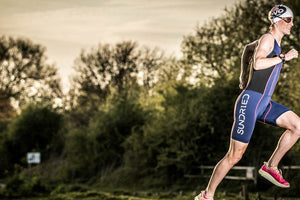If you've followed any type of marathon or half marathon training plan, you will no doubt have seen that you should be doing 'cross training' throughout the week as well as running. But what exactly is it? Which type is best? And how is it beneficial for runners? We answer all these questions and more.
What is cross training?
When most people hear the phrase 'cross training', they immediately think of the cross trainer (or elliptical) at the gym, but this isn't quite the case. Cross training for runners is simply any other type of training that can supplement and benefit your running training. A triathlete naturally does cross training by swimming, cycling, and running all together as part of their training, but runners can get stuck in a rut of just running. It's hugely important to do cross-training, read on to find out why.
Read more: 10 Tips To Survive Your First Marathon

Cross training benefits
So why should runners be doing cross training? Research has found that runners who do cross training such as strength training at a gym are less likely to get running injuries, are more likely to have a higher VO2 max, and are able to perform better. Of course it's perfectly logical that having stronger muscles would mean you are stronger in your running and will be able to get more power out of your training session.
Depending on the training plan you are following, you may find that cross training replaces some rest days. An intermediate marathon or half marathon training plan will often have you training 6 days a week, with 5 of those for running, 2 or 3 for cross training, and one for rest.
Read more: Cross Training Workout For Runners

Is yoga cross training?
Yoga is certainly a type of cross training, although it may not hold all of the benefits of other sports such as swimming, cycling, and strength training. Yoga has many benefits, such as lowering blood pressure, increasing flexibility, and improving posture and balance. All of these are things that would be beneficial to runners, and therefore doing yoga once a week as part of your training should help you to improve your running performance.

Is cycling good cross training for running?
Cycling is possibly one of the best types of cross-training for running as it targets the legs and core and therefore will strengthen the key muscle groups used when running. Not only this, as it is an aerobic exercise, you will be improving your fitness but it is a low impact activity so will give your joints a chance to rest.
A great way to train for the last part of a half marathon or marathon when you are running on empty and struggling to keep going is to do a brick workout. This is a type of workout employed by triathletes and duathletes whereby you go for a run straight after a bike ride. It gets your legs used to running when tired and is a great way for runners to practice keeping going when fatigued and running low on energy.

What is the best type of cross training?
Swimming
Swimming is a great way to cross-train as it is zero impact and so will give your joints a chance to recover from pounding the pavements while working your muscles hard. Not only this, it works your muscles in a completely different way to activities like gym workouts and cycling and so will give you a great full-body workout. On top of this, the breath control needed for swimming could help to put you in good habits with your running.
Strength Training
This is usually the most popular choice for runners as it is proven to be hugely beneficial to performance, physiology, and fitness. Lifting weights and working on your main muscle groups like core, back, and legs will have a significant impact on your running and will also help to improve the way you look.
Skipping
Skipping is an activity you may not have thought about for cross-training, but it can be hugely beneficial. Skipping works your calf muscles as well as testing the flexibility in your ankle joint, and this translates well to running as they can be areas that are neglected in other parts of training.








